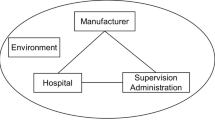Abstract
Purpose
Computer-assisted arthroplasty supports the surgeons in planning, simulating, and performing the replacement procedure, using robotic or navigation technologies. However, the safety of the technology has not been widely ascertained. Food and Drug Administration (FDA) database was interrogated about software-related recalls in computer-assisted arthroplasty, aiming to assess: (1) the incidence, (2) the root causes, and (3) the actions taken due to recalls.
Methods
The Medical Device Recalls database was investigated about software-related recalls in computer-assisted hip and knee arthroplasty surgery, between 2017 and 2022. The incidence of the software-related recalls, the root causes according to FDA and manufacturers, and the corrective actions taken by firms were determined.
Results
Eighteen recall numbers could be identified (1.6%), corresponding to 11 recall events. A total of 4634 units were involved. The FDA determined root causes were: software design (66.6%), design change (22.2%), manufacturing deployment (1, 5.6%), and design manufacturing process (5.6%). Among the manufacturers’ reasons for recalls, a specific error was declared in 16 cases (88.9%). In seven cases (43.8%), a coding error about lower limb alignment assessment was identified. Seventeen software-related recalls (94.4%) were classified as class 2; only one case was class 3 (5.6%). Return of the device was the main action taken by firms (8, 44.4%), followed by software update (7, 38.9%).
Conclusion
Software-related recalls in computer-assisted hip and knee arthroplasty were quite uncommon among all the recalls, deemed non-life threatening and usually due to software design errors. The main actions taken by manufacturers were the return of the device or the software update.

Similar content being viewed by others
Data availability
Data are available as supplementary materials.
Code availability
Not applicable.
References
Hazratwala K, Brereton SG, Grant A, Dlaska CE (2020) Computer-assisted technologies in arthroplasty: navigating your way today. JBJS Rev. 8(3):e0157. https://doi.org/10.2106/JBJS.RVW.19.00157
Medical Advisory Secretariat (2004) Computer-assisted hip and knee arthroplasty. Navigation and active robotic systems: an evidence-based analysis. Ont Health Technol Assess Ser. 4(2):1–39
Chen EA, Roof MA, Lygrisse KA, Kurapatti M, Hepinstall MS, Schwarzkopf R (2021) ICD-10 Coding mismatch in computer and robotic assisted primary total hip arthroplasty. J Arthroplasty 36(12):3934–3937. https://doi.org/10.1016/j.arth.2021.08.002
Wasterlain AS, Buza JA 3rd, Thakkar SC, Schwarzkopf R, Vigdorchik J (2017) Navigation and robotics in total hip arthroplasty. JBJS Rev 5(3):e2. https://doi.org/10.2106/JBJS.RVW.16.00046
Buza JA 3rd, Wasterlain AS, Thakkar SC, Meere P, Vigdorchik J (2017) Navigation and robotics in knee arthroplasty. JBJS Rev 5(2):e4. https://doi.org/10.2106/JBJS.RVW.16.00047
Ferrarese A, Pozzi G, Borghi F, Marano A, Delbon P, Amato B, Santangelo M, Buccelli C, Niola M, Martino V, Capasso E (2016) Malfunctions of robotic system in surgery: role and responsibility of surgeon in legal point of view. Open Med (Wars) 11(1):286–291. https://doi.org/10.1515/med-2016-0055
Cooper MA, Ibrahim A, Lyu H, Makary MA (2015) Underreporting of robotic surgery complications. J Healthc Qual 37(2):133–138. https://doi.org/10.1111/jhq.12036
Simone LK (2013) Software-related recalls: an analysis of records. Biomed Instrum Technol 47(6):514–522. https://doi.org/10.2345/0899-8205-47.6.514
– FDA (2022) Investigations operations manual 2022. Chapter 7: Recall Activities. https://www.fda.gov/media/75263/download. Accessed 16/08/2022
– FDA (2022) Medical Device Recalls database. https://www.accessdata.fda.gov/scripts/cdrh/cfdocs/cfres/res.cfm. Accessed 26/7/2022
- FDA (2022) Medical device recalls. Open FDA. https://open.fda.gov/apis/device/recall/. Accessed 25/08/2022
Vajapey SP, Li M (2020) Medical device recalls in orthopedics: recent trends and areas for improvement. J Arthroplasty 35(8):2259–2266. https://doi.org/10.1016/j.arth.2020.03.025
Pellerin C, Adamson M, Janney C (2020) Recall rates of total knee arthroplasty devices are dependent on the FDA approval process. Cureus. 12(8):e9744. https://doi.org/10.7759/cureus.9744
Peters W, Pellerin C, Janney C (2020) Research: evaluation of orthopedic hip device recalls by the FDA from 2007 to 2017. Biomed Instrum Technol 54(6):418–426. https://doi.org/10.2345/0899-8205-54.6.418
Connor MJ, Tringale K, Moiseenko V, Marshall DC, Moore K, Cervino L, Atwood T, Brown D, Mundt AJ, Pawlicki T, Recht A, Hattangadi-Gluth JA (2017) Medical device recalls in radiation oncology: analysis of US Food and Drug Administration Data, 2002–2015. Int J Radiat Oncol Biol Phys 98(2):438–446. https://doi.org/10.1016/j.ijrobp.2017.02.006
- FDA (2019) Changes to existing medical software policies resulting from section 3060 of the 21st century cures act. FDA guidance document. https://www.fda.gov/regulatory-information/search-fda-guidance-documents/changes-existing-medical-software-policies-resulting-section-3060-21st-century-cures-act. Accessed 14/08/2022
Author information
Authors and Affiliations
Contributions
All authors contributed to the study conception and design. Material preparation, data collection, and analysis were performed by Francesco Castagnini, Marco Maestri, and Enrico Tassinari. The first draft of the manuscript was written by Francesco Castagnini and Claudio Masetti. Cesare Faldini and Francesco Traina critically revised the first draft. All authors commented on previous versions of the manuscript. All authors read and approved the final manuscript.
Corresponding author
Ethics declarations
Ethics approval
The ethics approval was waived due to data anonymization and public database query.
Consent to participate
Not applicable.
Consent for publication
Not applicable.
Conflict of interest
The authors declare no competing interests.
Additional information
Publisher's note
Springer Nature remains neutral with regard to jurisdictional claims in published maps and institutional affiliations.
Study conducted in Bologna, Istituto Ortopedico Rizzoli.
Level of evidence: IV
Supplementary Information
Below is the link to the electronic supplementary material.
Rights and permissions
Springer Nature or its licensor (e.g. a society or other partner) holds exclusive rights to this article under a publishing agreement with the author(s) or other rightsholder(s); author self-archiving of the accepted manuscript version of this article is solely governed by the terms of such publishing agreement and applicable law.
About this article
Cite this article
Castagnini, F., Maestri, M., Tassinari, E. et al. Software-related recalls in computer-assisted hip and knee arthroplasty. International Orthopaedics (SICOT) 47, 641–645 (2023). https://doi.org/10.1007/s00264-023-05692-2
Received:
Accepted:
Published:
Issue Date:
DOI: https://doi.org/10.1007/s00264-023-05692-2




